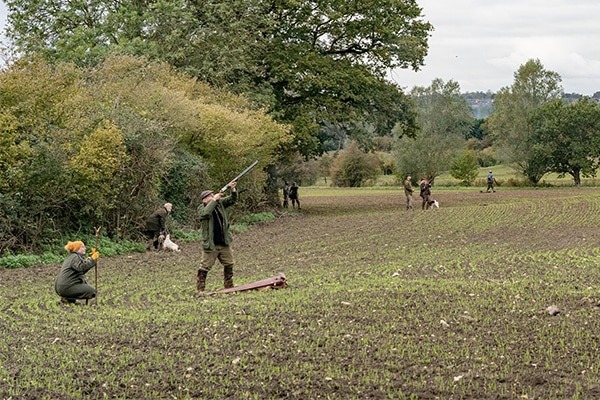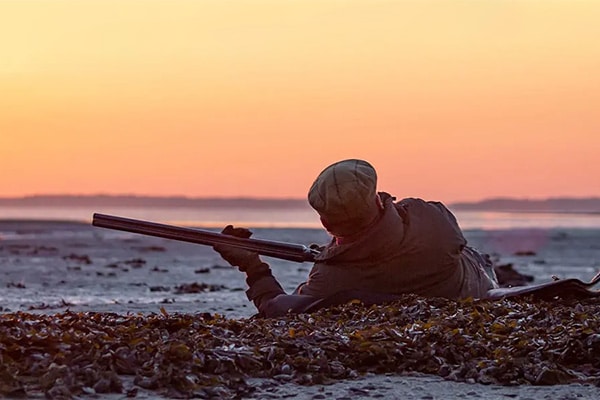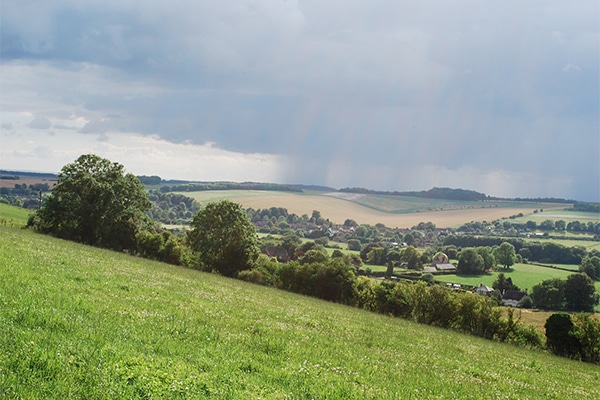
Shooting agreements and consents
Read about shooting agreements, permissions and consents, including links to download template documents.
Get information on the legal shooting season for mammals and birds in the UK.
Learn about our current conservation projects and how you can get involved.
Comprehensive information and advice from our specialist firearms team.
Everything you need to know about shotgun, rifle and airgun ammunition.
Find our up-to-date information, advice and links to government resources.
Everything you need to know on firearms law and licensing.
All the latest news and advice on general licences and how they affect you.


Wildfowling Wildfowling advice Flight ponds code of practice
At its broadest definition the flight pond is an open area of fresh water or marsh used by wildfowl in the evening, when they flight from their daytime resting places on estuaries or large water bodies in order to feed.
Flight ponds can therefore provide wildfowl shooting at dusk. Duck can also be shot as they leave a flight pond in the early morning. The wildfowl using such ponds may have been reared and released, or bred in the wild locally, or have travelled long distances to overwinter in the British Isles.
Mallard are most common but ponds can also attract teal and other species. Excessive or inconsiderate shooting is unacceptable, bad for conservation and is likely to reduce shooting success and bring all shooting sports into disrepute. If this code is followed, flight ponds will continue to provide excellent shooting with benefits to conservation which can be demonstrated to, and enjoyed by, a wider public.
High standards underpin public and political support for shooting, now and in the future.
The code provides advice at two levels:
The following golden rules apply:
When considering the creation of a new pond, investigate the need for consents from the local planning authority and the Environment Agency in England and Natural Resources Wales in Wales. In Scotland consult the planners and the Scottish Environment Protection Agency, and in Northern Ireland consult the Northern Ireland Environment Agency.
When creating a new pond, choose the location with care; boggy, wet grassland can have a higher conservation value than an inappropriately placed area of open water.
Consider the special status of surrounding or nearby land, particularly nature reserves, Sites of Special Scientific Interest or other land managed for shooting. Make sure you contact surrounding land managers to ascertain how best to integrate your own shooting plans with theirs.
Safety is of paramount importance and this Code of Practice recommends that:
Ensure that the location will minimise disturbance to nearby residents and livestock.
To avoid livestock damaging the margins of the pond it will be worth considering the need to install a fence around the perimeter. If livestock are using the pond for drinking water, an area can be left unfenced to allow access.
It is advisable to pattern your gun/cartridge combination to make sure it will deliver the appropriate killing load, provided, you can consistently centre your pattern on the target. Understand your own limitations with the gun and cartridge combination you are using. Get in touch for further advice.
Immediately mark all shot quarry, ensuring that it is retrieved as soon as it is safe to do so. Dispatch any wounded bird immediately, humanely and acceptably. A sharp knock on the head with a heavy stick or a priest can be effective as can the use of a purpose-made bird dispatcher.
The use of a trained gundog is essential in flight pond shooting, to find and promptly retrieve shot birds, especially those which fall in water. If you do not have a retrieving dog, only take shots which will result in birds falling on dry land and which you can retrieve. This may include times when the pond is frozen, since it can be dangerous to send a dog over ice.
Keep any dog under control at all times as livestock and other wildlife are often in the vicinity.
Always allow enough time for the retrieval of all shot birds before leaving the pond, and aim to leave the pond before the last birds arrive.
Guns should always be in place half an hour before expected flight time. Remember to always remove cartridge cases and all other litter.
If supplementary feeding is carried out, this Code of Practice recommends that care should be taken to avoid excess feed being left in or around the pond; it encourages pests such as rats and may lead to a degradation of the water quality.
Additional feeding may be needed in severe weather and if necessary on top of ice. As a guideline, increase the amount of food provided until some is left and then cut back slightly.
Generally a 10 litre (2 gallon) bucket of barley per 100 duck per day is sufficient
The Wildlife and Countryside Act 1981 and Wildlife (Northern Ireland) Order 1985 provide that mallard eggs may be collected from the wild (under general licence) until 31 March in England, Wales, and Scotland and in Northern Ireland until 10 April. Collected eggs must be incubated and every effort made to rear the ducklings. They must be released into the wild by 31 July.
In addition, this Code of Practice recommends that:
The number of birds released must be appropriate to the size and other characteristics of a flight pond, so as not to damage the habitat, of value to other wildlife. As a guide, when releasing mallard, 600 birds per hectare (250 birds per acre) of water is a maximum.
Any ducks must be released by 31 July.
The Wildlife & Countryside Act 1981 and Wildlife (Northern Ireland) Order 1985 provide for waterfowl shooting in the United Kingdom, with respect to quarry species, seasons and other aspects of the sport.
| Duck | Geese | Waders | Others |
| Gadwall | Canada goose | Common snipe | Coot2 |
| Goldeneye | Greylag goose | Golden plover | Moorhen2 |
| Mallard | Pink-footed goose | Jack snipe1 | |
| Pintail | European white-fronted goose3 | Woodcock | |
| Pochard | |||
| Scaup | |||
| Shoveler | |||
| Teal | |||
| Tufted duck | |||
| Wigeon |
Notes:
1 – Northern Ireland only,
2 – England, Wales and Scotland only,
3- As of 01/04/2020 Greenland white-fronted geese have been removed from quarry list.
Full details of open seasons for all legal quarry species are available from BASC.
Inland wildfowl seasons (All dates are inclusive)
For most flight pond shooting, where shooting ranges are typically short, a 12 bore gun with 28 – 32g (1 – 1 1/8oz) cartridges will normally be appropriate.
For large ducks (mallard) pellet size no. 4/5 (UK, i.e. 3.1/2.8mm) is widely used, for small ducks (teal) no. 6 (2.4mm), and for geese no. 3 (3.3mm) or 1 (3.6mm) when using high density shot types like bismuth and tungsten-based shot.
When using low-density types like steel, increasing pellet size by at least two sizes is recommended (i.e. from no. 6 to no. 4) and use a larger load weight (e.g. 32g to 34g or 36g) to ensure adequate number of pellets in the pattern.
Steel shot is very hard and it is important to use steel cartridges that are suitable for the gun you intend using. The International Proof Commission (CIP) has defined two types of steel cartridge, standard and high performance.
Broadly, standard steel cartridges can be used in standard/magnum-proved guns but high-performance cartridges must be used only in guns that have passed special Steel Shot Proof.
Cartridge lengths up to 70mm typically will be standard but 76mm and larger, high performance. The performance of each type of cartridge is regulated too, in terms of its velocity, momentum and pellet size, and, with large pellet size, choke is limited to no more than half. The cartridge box should say if the cartridges are high performance.
Bismuth shot is available in many cartridge and pellet sizes and can be used through any choke, including traditional game guns. It is recommended that at least one shot size larger is used compared with lead, due to it being slightly less dense. Bismuth is often chosen by shooters using 65 or 70mm-chambered guns.
Impact Tungsten Matrix (ITM) shot is close to the density of lead and is available in many shot size and cartridge combinations. It can be used through any choke. The same size shot as was used in lead can be used but one size larger may also be worth trying.
Hevi-shot is a combination of tungsten, steel and nickel and is denser than lead. As for steel, it should be fired from plastic-wadded cartridges. CIP regulations now treat the current form of Hevi-shot, unlike the previous form, as lead and not subject to the rules for steel shot.
This shot can perform well but should not be used to extend your shooting range beyond your own limits. A pellet size slightly smaller than you would use in lead is worth trying as it could increase the lethality of the load.
A growing variety of non-lead shot types, based on the above materials, is becoming available. Further information and advice on non-lead shot can be obtained from the BASC’s wildfowling department.
Many shooters have their own views as to what constitutes a killing load. The best available guidance at present is based on American scientific studies on steel shot, and, most recently, Hevi-shot.
The measure of potential effectiveness is the count of pellets in the traditional 30 inch circle placed over the centre of the pattern. For example: geese need a minimum 55 pellets in that circle; large ducks (mallard) need 90+; small ducks (teal) some 140. Effective pellet sizes vary accordingly.
You need to pattern your gun/cartridge combination to make sure it will deliver the appropriate killing load – provided, as ever, you can consistently centre your pattern on the target. Get in touch for further advice.
The maximum effective range of your shotgun in relation to a given kind of quarry is the greatest range at which you are reasonably certain that a clean kill will be made by a truly-aimed shot.
Consistently hitting and killing your target, with the appropriate gun/cartridge combination, is the most important factor in successful shooting. In effect, this means that with an appropriate 12-bore cartridge the maximum effective range could be some 32-37m (35–40yd), but it may well be less than this, depending on your ability to shoot well.
If you cannot hit and kill your target consistently at 25yd, you should not attempt to shoot at that range. As your shooting skill improves, you can extend your range.
The Wildlife and Countryside Act 1981 and Wildlife (Northern Ireland) Order 1985 provide for wildfowl shooting in the United Kingdom.
Shooting on Sunday and at night
The use of lead shot for shooting over wetlands is greatly restricted in Great Britain. In England and Wales the use of lead shot has been banned for the shooting of all duck, geese, coots and moorhens wherever they occur, as well as on or over all foreshore and specified Sites of Special Scientific Interest.
It is the duty of all shooters to be aware of and comply with the restrictions and any others imposed at site level. In Scotland, the use of lead shot is banned for all shooting on or over most wetlands, including flight ponds and foreshore.
In Northern Ireland from 1 September 2009 regulations came into force prohibiting the use of lead shot to shoot any species of bird or animal on or over wetlands.
Anyone shooting with lead shot on or over wetlands on or after 1 September 2009 is committing an offence and liable to prosecution; conviction can result in a fine of up to £1,000.
In addition to the law the Code of Good Shooting Practice, endorsed by the major shooting and countryside organisations, calls on all shooters to avoid depositing lead shot into wetland areas used by feeding waterfowl.
The Wildlife and Countryside Act 1981 and Wildlife (Northern Ireland) Order 1985 provide for periods of special protection for all wildfowl (including reared mallard, woodcock and snipe) in prolonged severe weather. Prior to such statutory protection being introduced by the government, BASC may recommend voluntary restraint where appropriate.
Details of the suspension of shooting due to severe weather are posted in the national press and sporting magazines. Information and guidance is made available through BASC head office, regional offices and the BASC website. It is important for the image of shooting to be seen to be acting responsibly during such periods.
It is advisable to have adequate legal liability (third-party) insurance when shooting. Membership of BASC currently includes insurance.

Read about shooting agreements, permissions and consents, including links to download template documents.

Bid on three days’ guided wildfowling at Lindisfarne, with food and accommodation for two Guns.

BASC-affiliated wildfowling clubs manage sporting rights on approximately 700km of foreshore owned by The Crown Estate in England, Wales and Northern Ireland.
Sign up to our weekly newsletter and get all the latest updates straight to your inbox.
© 2023 British Association for Shooting and Conservation. Registered Office: Marford Mill, Rossett, Wrexham, LL12 0HL – Registered Society No: 28488R. BASC is a trading name of the British Association for Shooting and Conservation Limited which is authorised and regulated by the Financial Conduct Authority (FCA) under firm reference number 311937.
If you have any questions or complaints about your BASC membership insurance cover, please email us. More information about resolving complaints can be found on the FCA website or on the EU ODR platform.
This website uses cookies so that we can provide you with the best user experience possible. Cookie information is stored in your browser and performs functions such as recognising you when you return to our website and helping our team to understand which sections of the website you find most interesting and useful.
Strictly Necessary Cookie should be enabled at all times so that we can save your preferences for cookie settings.
If you disable this cookie, we will not be able to save your preferences. This means that every time you visit this website you will need to enable or disable cookies again.
This website uses Google Analytics to collect anonymous information such as the number of visitors to the site, and the most popular pages.
Keeping this cookie enabled helps us to improve our website.
Please enable Strictly Necessary Cookies first so that we can save your preferences!
More information about our Cookie Policy